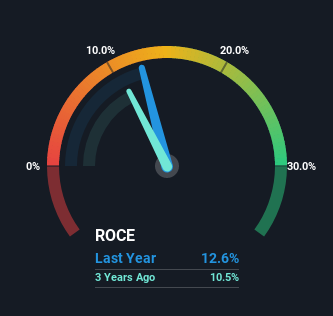- India
- /
- Transportation
- /
- NSEI:NECCLTD
North Eastern Carrying (NSE:NECCLTD) Could Be Struggling To Allocate Capital

If you're looking at a mature business that's past the growth phase, what are some of the underlying trends that pop up? More often than not, we'll see a declining return on capital employed (ROCE) and a declining amount of capital employed. Trends like this ultimately mean the business is reducing its investments and also earning less on what it has invested. On that note, looking into North Eastern Carrying (NSE:NECCLTD), we weren't too upbeat about how things were going.
Return On Capital Employed (ROCE): What is it?
For those that aren't sure what ROCE is, it measures the amount of pre-tax profits a company can generate from the capital employed in its business. To calculate this metric for North Eastern Carrying, this is the formula:
Return on Capital Employed = Earnings Before Interest and Tax (EBIT) ÷ (Total Assets - Current Liabilities)
0.13 = ₹123m ÷ (₹2.1b - ₹1.1b) (Based on the trailing twelve months to December 2021).
So, North Eastern Carrying has an ROCE of 13%. In absolute terms, that's a pretty normal return, and it's somewhat close to the Transportation industry average of 11%.
View our latest analysis for North Eastern Carrying

Historical performance is a great place to start when researching a stock so above you can see the gauge for North Eastern Carrying's ROCE against it's prior returns. If you want to delve into the historical earnings, revenue and cash flow of North Eastern Carrying, check out these free graphs here.
The Trend Of ROCE
There is reason to be cautious about North Eastern Carrying, given the returns are trending downwards. To be more specific, the ROCE was 20% five years ago, but since then it has dropped noticeably. Meanwhile, capital employed in the business has stayed roughly the flat over the period. This combination can be indicative of a mature business that still has areas to deploy capital, but the returns received aren't as high due potentially to new competition or smaller margins. So because these trends aren't typically conducive to creating a multi-bagger, we wouldn't hold our breath on North Eastern Carrying becoming one if things continue as they have.
On a separate but related note, it's important to know that North Eastern Carrying has a current liabilities to total assets ratio of 54%, which we'd consider pretty high. This can bring about some risks because the company is basically operating with a rather large reliance on its suppliers or other sorts of short-term creditors. Ideally we'd like to see this reduce as that would mean fewer obligations bearing risks.
Our Take On North Eastern Carrying's ROCE
In summary, it's unfortunate that North Eastern Carrying is generating lower returns from the same amount of capital. Investors haven't taken kindly to these developments, since the stock has declined 45% from where it was five years ago. Unless there is a shift to a more positive trajectory in these metrics, we would look elsewhere.
North Eastern Carrying does have some risks, we noticed 4 warning signs (and 2 which are concerning) we think you should know about.
For those who like to invest in solid companies, check out this free list of companies with solid balance sheets and high returns on equity.
Valuation is complex, but we're here to simplify it.
Discover if North Eastern Carrying might be undervalued or overvalued with our detailed analysis, featuring fair value estimates, potential risks, dividends, insider trades, and its financial condition.
Access Free AnalysisHave feedback on this article? Concerned about the content? Get in touch with us directly. Alternatively, email editorial-team (at) simplywallst.com.
This article by Simply Wall St is general in nature. We provide commentary based on historical data and analyst forecasts only using an unbiased methodology and our articles are not intended to be financial advice. It does not constitute a recommendation to buy or sell any stock, and does not take account of your objectives, or your financial situation. We aim to bring you long-term focused analysis driven by fundamental data. Note that our analysis may not factor in the latest price-sensitive company announcements or qualitative material. Simply Wall St has no position in any stocks mentioned.
About NSEI:NECCLTD
Solid track record with adequate balance sheet.
Similar Companies
Market Insights
Community Narratives




